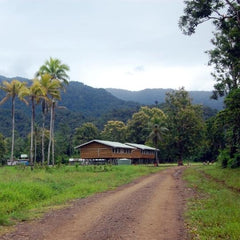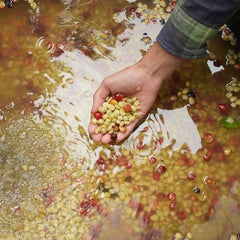Everything You Need to Know About Coffee from Papua New Guinea
Papua New Guinea is one of the main producers of coffee, and coffee production is the country’s second-largest agricultural export.
People around the globe love Papua New Guinea coffee because it has a uniquely crisp flavor.
Understanding where your coffee comes from can help you anticipate its flavor and know what drink you are putting in your mouth. One country your coffee may come from is Papua New Guinea. It is estimated that about 210,000 acres of land are exclusively dedicated to coffee cultivation.
The History of Coffee in Papua New Guinea

Coffee has not always been in Papua New Guinea. Its production first started in 1926 when Jamaican Blue Mountain Coffee seeds were planted. By 1928, the country was ready for commercial production with a total of 18 commercial plantations established in the country.
By the 1960s, Papua New Guinea’s infrastructure grew, which allowed them to produce and sell even more coffee than before. The country’s coffee industry boomed in the 1970s and added to the international market as other countries’ coffee productions were in a slump.
Just a few years later in the 1980s, national production of coffee dropped because the coffee plantations decentralized to focus more on small coffee farmers. That did not stop the country, though. By 1998, the country’s coffee industry hit a peak. Coffee became about 13% of the country’s total exports.
Coffee Production in Papua New Guinea Today

Over the last two decades, the country has faced some contemporary problems. However, coffee has still remained a major part of the Papua New Guinea culture. About 2.5 million people in Papua New Guinea work in the coffee industry as a result. It is estimated that 1% of world coffee production comes from Papua New Guinea.
Today, Papua New Guinea coffee is primarily sold in order to make espresso, cappuccino, and lattes. Because of these coffee types, it makes sense that Papua New Guinea coffee is most popular in European markets and American markets.
Still, Papua New Guinea coffee is not as popular as other types. This is largely due to the fact that Papua New Guinea does not have the infrastructure to export its coffee productions. Even so, coffee production remains one of the top industries for the country.
Western Highlands vs Eastern Highlands

It’s important to note that not all Papua New Guinea coffee is grown in the same area. The Western Highlands produce the most coffee and it is home to large coffee farmers. In contrast, the Eastern Highlands valleys are where a lot of smaller coffee farms are located.
Interestingly, even though the biggest coffee farms are located in the Western Highlands, Papua New Guinea’s main port city is actually in the Eastern Highlands in Lae. Large farms can ship to this location, whereas small farmers often travel out of their way to the port.
What Types of Coffee Come from Papua New Guinea?

Nearly all Papua New Guinea coffee is a washed mild arabica highland variety. Only about 5% of the country’s coffee production is lowland washed robusta coffee, which is darker, more bitter, cheaper, and less flavorful than the more popular variety.
There are large coffee plantations and small local farmers. The larger estates produce coffee through wet processes that are sold to US markets. Starbucks is a popular US buyer of Papua New Guinea coffee. In comparison, many small farmers produce organically grown coffee that isn’t as commercially sold. These farmers also stick to the wet processes and primarily sell arabica highland coffees.
Even though some local farmers produce incredibly healthy, delicious, and organic coffee, there have been problems with the quality and safety of small farm growers from Papua New Guinea. The larger estates have more control and consistency in their beans. Unfortunately, this is not really an option for smaller growers.
What Does Papua New Guinea Coffee Taste Like?

The unique thing about Papua New Guinea coffee is that it doesn’t taste like most other coffee varieties. Papua New Guinea island is filled with fertile soil. This fertile soil creates beans with crisp flavors, including citrus acidity, chocolate undertones, and tropical fruit flavors.
Most agree that Papua New Guinea coffee has a medium to high body and medium acidity with berry and dark chocolate flavors. The finish of this coffee is surprisingly clean. Here is a closer look at the expected flavor of Papua New Guinea coffee:
- Aroma: Mango, papaya, or exotic fruit
- Taste: Slightly unpredictable; fruity, floral, acidic, clean, and full-bodied
- Aftertaste: Low and deep
How Papua New Guinea Coffee Is Produced

In addition to the fertile ground, Papua New Guinea coffee is different from other similar coffee varieties because of the way it is harvested and produced.
For starters, even the larger farmers focus on selectively growing the coffee plants. The reason for this is that there is simply not as much space in Papua New Guinea as there is in other countries. This smaller harvest means that the growers can give more care and concern to the individual plants.
Once the beans are ready to be harvested, they’re picked and hand washed. The processing includes a wet process, which is unique for the region. Together, the small farms mixed with wet processing create high-quality beans that are uniquely flavored.
What Is the Best Way to Prepare Coffee from Papua New Guinea?

Traditionally, Papua New Guinea coffee is prepared in an espresso machine or French press. These machines allow for the fruity and floral flavors to be at the forefront of this bold cup of coffee. The medium roast will keep the light and cheerful acidity, whereas a medium-dark roast will create a richer cup.
Unfortunately, there aren’t many Papua New Guinea instant coffee options. This is largely due to the fact that Papua New Guinea coffee is not as commercially available as Indian or Colombian coffee. Hopefully, this coffee will become more commercially available as the country’s infrastructure improves.




















